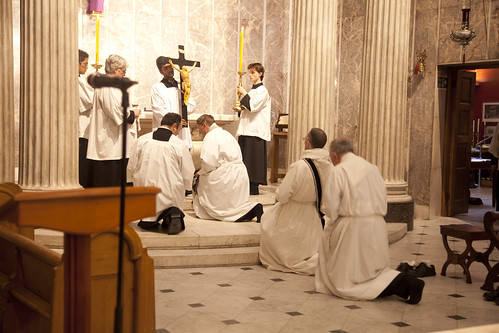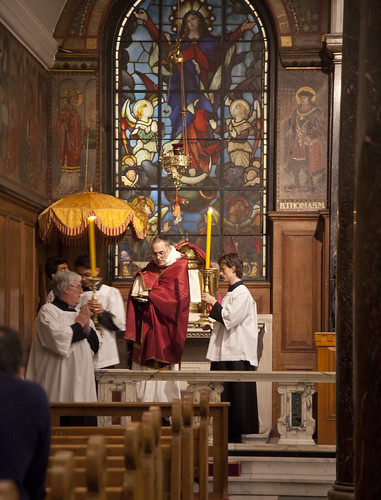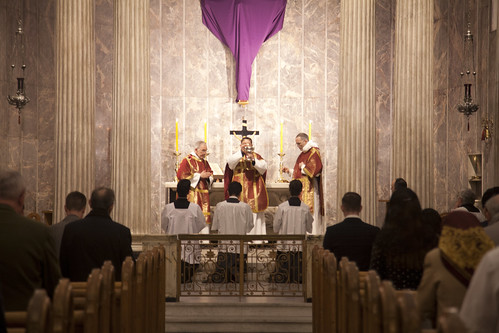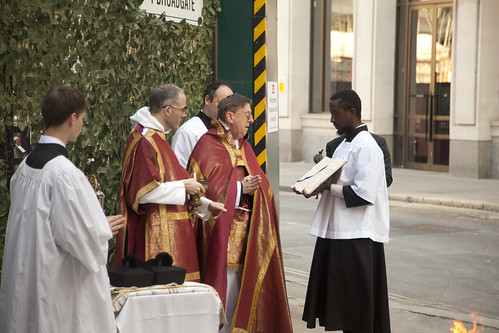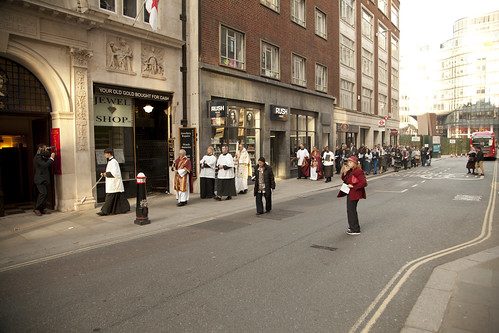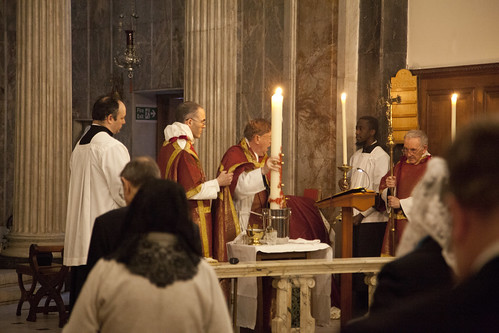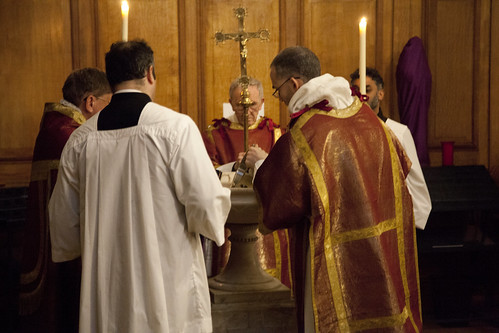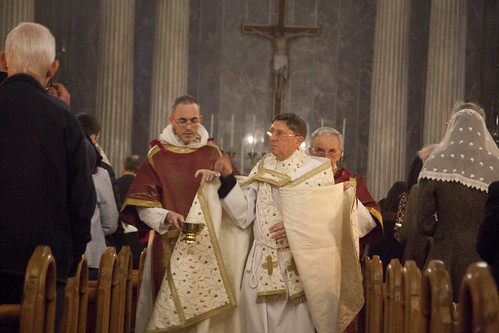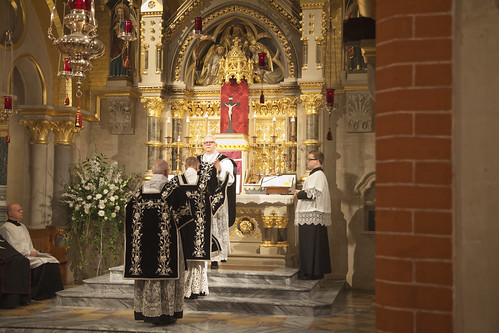Chairman's Blog
Summer Mass of Ages! Get your copy now.
To have it delivered each quarter, join the LMS!
If your local church doesn't get it, you can order a copy - it is free so you only pay the postage.
You can read it online on ISSUU.
In this issue: • Joseph Shaw reviews the Raphael exhibition at the National Gallery until 31 July • Charles A. Coulombe remembers Dr Halliday Sutherland, a remarkable and wise Catholic convert • Alan Frost explains how devotion to the Rosary was revived in the late 15th century by a Dominican Friar • Joseph Shaw reviews six short but important books
Our regular columnists:
• The Chairman’s Message: On what we should all be promoting
• Family Matters: James Preece on how our love of God should not remain purely theoretical
• Art and Devotion, Caroline Farey on a late 15th century Netherlandish picture by Juan de Flandes
• Rome Report, Diane Montagna talks to Abbé Brice Meissonnier, parish priest of Santissima Trinità dei Pellegrini
• Architecture: At a time when Ukraine is very much in the news, Paul Waddington takes a look at the London cathedral of the Ukrainian Greek Catholic Church
• Mary O’Regan suggests we pray for our detractors
• Wine: Sebastian Morello on the ales of The Chiltern Brewery
• World News: Paul Waddington reports from around the Globe
We promote the walking pilgrimage from Canterbury to Ramsgate, organised by the Marian Franciscans and The St Benedict Academy in Preston, who are looking to appoint tutors for the coming academic year.
LMS Walsingham Pilgrimage 2022
Review of Kwasnieski 'True Obedience'
 |
| Obedient unto death: shrine of the Chideock Martyrs in England. Bishop O'Toole on the occasion of a pilgrimage Mass celebrated for the Latin Mass Society by the Institute of Christ the King Sovereign Priest. |
There has long been a strange asymmetry between conservatives and progressives in the Catholic Church. Theological conservatives—priests and bishops as well as lay people—have prided themselves on their obedience, and progressives have flaunted their disobedience. To give the most extreme examples, progressive bishops would make their chums laugh by talking about how they had tossed the latest Instruction from Rome—on liturgical abuses, for example—into the bin. Conservatives would obey rules and superiors’ orders even if it broke their hearts to do so, for example the rule forbidding the celebration of the older form of the Mass from Rome, or a demand by their own bishop to wreck their church’s sanctuary.
Differing conceptions of the virtue of obedience is only part of the explanation for this phenomenon. The other side was political realism. Both sides knew that when push came to shove most bishops, bishops’ conferences, the Catholic media, and often the Holy See as well, would enforce rules and back up superiors when they pushed the progressive agenda, but not when they sought to preserve things which conservatives held dear. Although in theory no priest is obliged to have females serving the Altar, in practice endless problems nearly always await priests who do not. Although in theory denying the teaching of the Church on contraception or the Resurrection should get a priest into very serious trouble, up to and including suspension as a priest and excommunication, in practice this almost never happens.
Reply to Gavin Ashenden: the evangelising power of the Traditional Mass
 |
| Evangelising by doing something recognisably sacred: Walsingham Pilagrimage |
Cross-posted from Rorate Caeli.
I have an article in the current issue of Inside the Vatican, and by coincidence it is preceded by one by Dr Gavin Ashenden, the former Anglican cleric received into the Catholic Church just before Christmas. Ashenden has become an important commentator on Catholic affairs, so I was dismayed to read his treatment of the movement for the Traditional Mass, which is the subject of his article. I think, however, that Dr Ashenden’s analysis may appeal to many, in trying to put together the kinds of things Pope Francis has said along with a perhaps superficial knowledge of the movement itself. For this reason, as well as because of the respect I have for him as an intellectual, I would like to make a response.
His article is not freely available online but it is possible to buy access to just this issue of Inside the Vatican, May-June 2022, through the ISSUU platform, for a small sum, if anyone thinks I am misrepresenting him.
The first thing with which I would like to take issue is the background Ashenden proposes for the debate about the liturgy. He writes:
The civil war that dominates our day has narrowed down to a fight over liturgy. But only because liturgy has become emblematic of two ways of looking at the world; two perspectives, two competing theologies.
This seems to me a very odd, and potentially a very distorting, way of looking at the current situation of conflict in the Church. Perhaps supporters of the Traditional Mass should be flattered, because it makes them seem very important, but the fact is that opposition to Pope Francis’ real or imagined agenda, which is what the ‘civil war in the Church’ is presumably about, does not have traditional Catholics as major protagonists or the traditional liturgy as a major issue.
It may be objected that traditionalists punch above their weight in Catholic journalism, and so the liturgical issue is endlessly discussed. This is true, but this is not where the fight is centred. Traddies have scarcely any presence among bishops and cardinals—they have been systematically excluded from these roles for fifty years, after all—and it is among bishops and cardinals that the war is raging. The wealthy, powerful, and numerous German bishops persist with their ‘Synodal Pathway’ towards same-sex unions, holy communion for the divorced and remarried, and women’s ordination; in March this was publicly criticisedby the Episcopal Conference covering Scandinavia, and in April, it was attacked by 70 bishops from the USA and other countries. These criticisms make public in an extraordinary way a conflict which is theologically profound and global in scale.
No doubt there is a correlation between friendliness towards Latin Mass communities and opposition to the German agenda of blessing same-sex unions and ordaining women, but it would be easy to give examples on both sides which buck the trend. The Traditional Mass is far more welcome in Germany than it is in Tanzania, and yet fourteen Tanzanian bishops felt moved to sign the petition criticising the Synodal Pathway. I don’t think any of the relevant documents on either side even mention the old Mass.
There is, of course, a fight about the liturgy going on, and within this rather niche area in the life of the Church the ancient Mass has a bit more significance. Ashenden describes it in this way:
Tradition presents the fruit of a long steady development of depth under the hand of the Holy Spirit; the contemporary quest claims to re-connect with the earliest sources, and at the same time attempts to build a bridge between the Church and secular proprieties in a society experiencing rapid change.
There is virtue in both a liturgy that prioritizes transcendence and virtue in one that prioritizes immanence. One prioritizes profundity over easy access, and the other facilitates evangelism in a culture that finds the Faith increasingly strange and unfamiliar.
This is the second area in which I would like to object. Here Ashenden does no more than summarise a few conventional views on the old vs. new debate, so perhaps it is not him I am criticising here so much as those widespread assumptions which he has summarised for us.
First, I have, frankly, no idea what work the ‘immanent’ vs. ‘transcendent’ contrast is supposed to be doing here. It would be interesting to hear how the reformed Mass creates a sense of the immanent presence of God, but I’ve never seen an attempt to make this case. What I have heard is that the reformed Mass simply has a tendency not to create a sense of God’s presence at all. Indeed, this is implied by the words of Popes John Paul II, Benedict XVI, and Francis, who all noted the ‘sacrality’ of the ancient Mass, and also of the Eastern Rites, and contrasted this with the reformed Mass as all too often celebrated.
People may be surprised to hear that all three Popes can be quoted to this effect, but I am thinking of Pope John Paul II’s 2001 addressto the Congregation for Divine Worship, Pope Benedict’s 2007 Letterto Bishops, and an interviewof Pope Francis in July 2013.
I have a similar problem with the idea that the reformed Missal ‘facilitates evangelism in a culture that finds the Faith increasingly strange and unfamiliar’. Certainly, the reform implemented strategies to this effect, but so does the older Missal.
In some ways the reformed Missal signally fails to ‘build a bridge’ with culture. Thus, the world celebrates St Valentine’s Day on 14th February and the Church, as far as the reformed liturgy goes, fails to do so. In this case, far from building a bridge with culture, the reform seems to burn down a bridge which previously existed. Annibale Bugnini expressed his frustration that he was unable to break the similar connection between Ash Wednesday and Mardi Gras (The Reform of the Liturgy, p307, n7). The reformers’ problem with these bridges to popular culture is that they felt the Church had become too culturally weak to cope with the distorted popular meanings of these events. The thing to do in response is to withdraw: to pull up the drawbridge, to retreat into our shell.
Nevertheless, there is a strategy for engaging the world implicit in the liturgical reform. This is the theory that if people experience the Mass as something less alien, more everyday—fresh modern language, pottery chalices, a plain table for an altar, the priest in ordinary clothes—then the message of the Mass will carry over more easily into their everyday lives. Whether this works, of course, is an empirical question.
One problem with this approach, hinted at in my examples, is that the Church has never done this wholeheartedly. The stilted English of the 1974 ‘old ICEL’ has now given way to a deliberately elevated liturgical register in the 2011 ‘new ICEL’ translation. Pottery chalices are actually forbidden. Priests are obliged to wear vestments. And so on.
Leaving that problem aside, one can accept that there was a sincere and heartfelt attempt to evangelise the world in this way, and still notice that the ancient Mass alsoattempts to evangelise culture, also builds bridges, in a very differentway. This is the strategy of a maximally clear differentiation between the sacred and profane, to create a really palpable sense of the sacred, which can stay with the worshipper from Sunday to Sunday.
Ashenden has slipped into characterising the contrast between the two liturgical forms in terms of the self-understanding of just one of them. Because the reform aimed to make the liturgy more effective for evangelisation, he assumes that this effectiveness now marks the difference between the two liturgical forms. Is there, however, any reason to think that the reform actually worked in this respect? This is, let us say, far from clear. The recent researchpresented by the sociologist of religion, Prof. Stephen Bullivant, suggests that the strategy of contrast, of contrasting the sacred with the profane, of building walls around the community, and of encouraging visible testimonies to the truth of the Faith—all-night vigils, long walking pilgrimages, demanding fasts—is actually more effective in maintaining and spreading the Faith than trying to erase the boundaries.
Related to this is Ashenden’s unqualified acceptance of what Pope Francis says about ‘rigidity’.
Pope Francis is using the word rigid as a criticism. He perceives opportunity. The rigid are those who cannot see opportunity or be sufficiently flexible to make anything of it.
Pope Francis is no doubt sincere in saying this kind of thing, but he is not necessarily correct. The idea here, ultimately derived from Freud via Adorno, is that ‘rigid’ people are attached to traditional forms, due to the childhood repression of sexuality, and are cursed with a lack of creativity and morbid risk aversion. For all the influence this theory has had, it was never very well supported by the empirical data, and intellectual fashions have long since moved on. The ideas of the 1940s and ’50s don’t necessarily provide the best lens for understanding the 2020s.
As Ashenden must have noticed, evangelising creativity and effectiveness today is often associated with the more conservative and demanding forms of the major world religions, and Catholicism is no exception. Indeed he has noticed the ‘the growth of the young traditionalists’. Where does he think they came from?
A final point I would like to raise in this already over-long response to this article relates to this very puzzling sentence:
[Ashenden wants to ask] why those supporters of the Tridentine mass, like the head of SSPX, Fr. Davide Pagliarani, repudiate the validity of the Novus Ordo that mediates immanence?
First, it is strange to make Fr Pagliarani a kind of representative or spokesman for the movement in dialogue with Pope Francis over Traditionis Custodes. Because it is canonically irregular, the SSPX is not effected by Traditionis Custodes or by anything else Pope Francis might decree. If it were the views of the SSPX that brought forth this document, it would be unjust to the point of weirdness. Why punish non-SSPX traditional Catholics for the views of the SSPX?
Second, I think Fr Pagliarani would be pretty surprised, and not very pleased, to hear it suggested that he ‘repudiates the validity of the Novus Ordo.’ I really wish Ashenden, and others, would be careful in what he says on this subject, as it is a matter of considerable sensitivity. It has never been the official view of the SSPX that the Novus Ordo Mass, if celebrated according to its own rules, is sacramentally invalid. Such a view is extremely marginal in the traditional Catholic world, and unsurprisingly so as its implications are mind-boggling. If you start saying that the reformed sacramental rites are invalid—and if the Mass is invalid, where do you stop?—then by today the Church would have essentially ceased to exist outside a few beleaguered enclaves.
This is nonsense, and Dr Ashenden really should not give it credibility.
Liturgy and the War in Ukraine: Inside the Vatican
Good will implies that we take the religious values of the region seriously. The liturgical debate taking place in the Western Church, particularly after Traditionis Custodes, can leave one with the impression that the Western Catholics, at bottom, see the whole phenomenon of the Eastern Rites as faintly ridiculous, and accordingly that disagreements among their different groupings is little more than a squabble among foolish children. This impression will not be dispelled until the Holy See has made its peace with its own liturgical tradition, and gives it the place of honour which Pope Benedict XVI hoped for it, and from which Pope Francis has tragically plucked it.
Support the Latin Mass Society
Triduum Photos
More mischevious nonsense from The Pillar
April 14th this year was Maundy Thursday. It is an interesting day for The Pillar to choose to publish a shoddy attack on two Catholic intellectuals, Prof Thomas Pink and Fr Edward Waldstein, for their alleged 'integralist' views, in an interview by Charlie Camosy with Joseph Capizzi.
Plant the critique out there in public, on the day in the year the victims are least likely to notice it quickly or react before the social media circus has moved on. Better still, if someone--like me--does notice and uses Twitter to call on the Pillar's editors, J.D. Flynn and Edward Condon, to account for it over the following 24 hours, they can just piously not react for the duration.
So here I am drawing attention to this interview once again. I happen know the targets of this piece. Prof Pink is a Patron of the Latin Mass Society. I know Fr Waldstein a little from the Roman Forum Summer Symposium. There are a great many would-be lay intellectual leaders of the Catholic world, and the field is quite crowded even if you focus on the Traditional Catholic niche, but Prof Pink and Fr Waldstein are the real thing: they are established and respected academics who are orthodox Catholics and engaged in some of the fundamental issues of the day. Prof Pink is one of the foremost Catholic intellectuals in the UK.
Accordingly, I suppose it is not surprising that they should be the focus of asinine criticisms. Towards the end the interviewer Camosy tries to draw in a gaggle of other names into the discussion, but Capizzi doesn't really rise to the bait.
The major figures seem to be primarily online, as I haven’t seen much of their work in standard theological journals. The two (English-speaking) who jump first to mind are Thomas Pink and Edmund Waldstein.
I take their central claim to be that, just as man has two ends, spiritual and temporal, and that man’s temporal end is ordered to his spiritual end, so must the juridical authorities of the world be hierarchically ordered: the temporal juridical authority to the spiritual juridical authority.
In other words, the state should be subordinate to the Church. Relatedly, then, any political order is deficient to the degree it fails to seek this hierarchization of juridical authorities, or denies the existence of the spiritual juridical authority. Thus, “liberalism” must be rejected if and when it denies such ordering — or the existence of the spiritual juridical authority.
59. Men, however, composed as they are of bodies and immortal souls, can never in this mortal life succeed in satisfying all their needs or in attaining perfect happiness. Therefore the common good is to be procured by such ways and means which not only are not detrimental to man’s eternal salvation but which positively contribute to it.
The Church and the political community in their own fields are autonomous and independent from each other. Yet both, under different titles, are devoted to the personal and social vocation of the same men. The more that both foster sounder cooperation between themselves with due consideration for the circumstances of time and place, the more effective will their service be exercised for the good of all. For man's horizons are not limited only to the temporal order; while living in the context of human history, he preserves intact his eternal vocation.
Monday Masses in London
- 2nd May: St ATHANASIUS
Missa Euge Bone, Tye
Surrexit Pastor Bonus, L’Heritier
Dum Transisset, Taverner
- 23rd May: VOTIVE MASS FOR PEACE
Missa Vidi Speciosam, Victoria
O Maria Vernans Rosa, Clemens non Papa
Christe qui Lux est Dies, White
- 6th June: WHIT MONDAY
Missa Dum Complerentur, Palestrina
Dum Complerentur, Victoria
Loquebantur Variis Linguis, Tallis
- 20th June: Octave Mass of CORPUS CHRISTI
Missa Viri Galilei, Palestrina
Viri Galilei, Palestrina
O Sacrum Convivium, Guerrero
- 4th July: Octave Mass of SS PETER AND PAUL
Missa Papae Marcelli
Credo Quod redemptor, Parsons
Adolescentes sum ego, Mundy
- 25TH July: St JAMES
Missa Simile Est Regnum, Victoria
Sancta Maria, Victoria
Ave Verum, Byrd
- 15th AUGUST: THE ASSUMPTION OF THE BVM
Missa Assumpta Est Maria, Palestrina
Ave Virgo Sanctissima, Guerrero
Ave Maria Gemma Virginum, Mouton
- 22nd August: THE IMMACULATE HEART OF THE BVM
Missa Sicut Lilium Inter Spinas, Palestrina
Ave Maria 5, Palestrina
Salve Regina a 5, Victoria
FIUV Magazine, Gregorius Magnus, now out!
Support the Latin Mass Society
Sponsorship for Royal School of Needlework Course from the Guild of St Clare
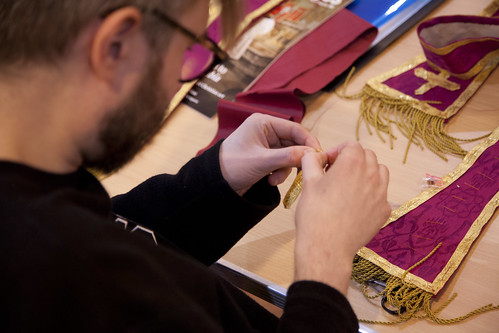 |
| One of our sponsored students, helping to make a replacement stole for a violet Low Mass set belonging to the Latin Mass Society |
 |
| A Certificate Course piece of work by the other of our current sponsored students. |







